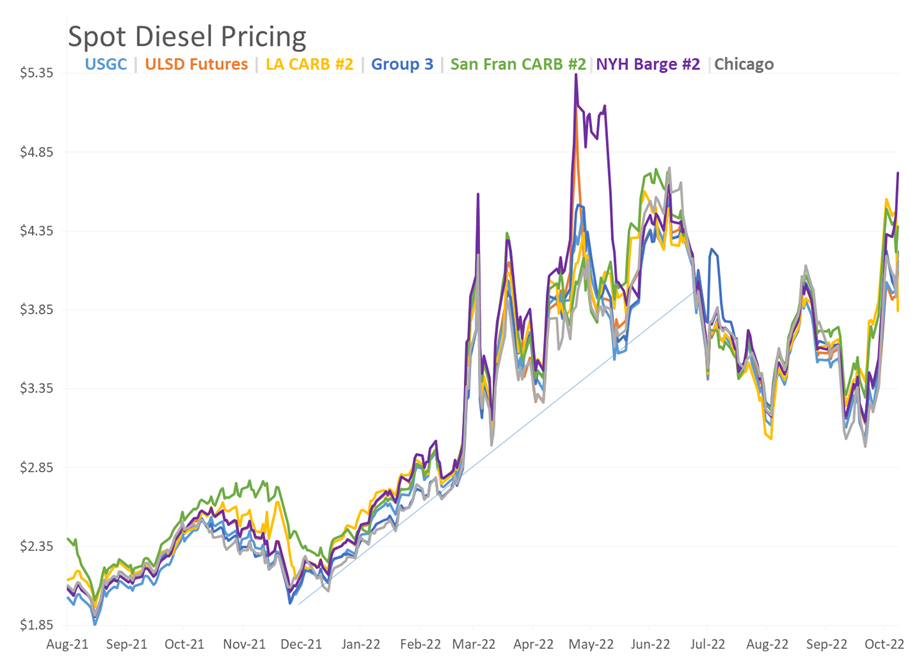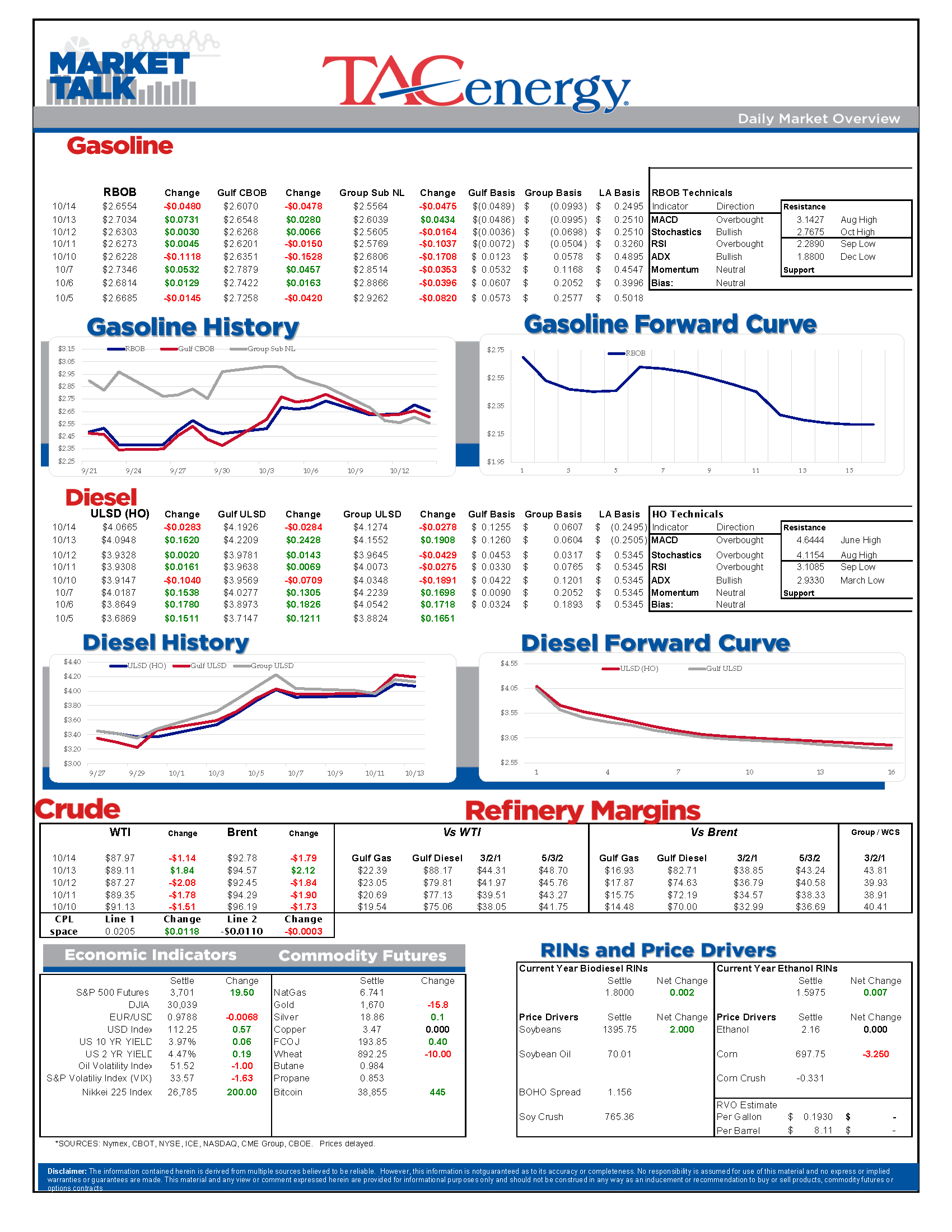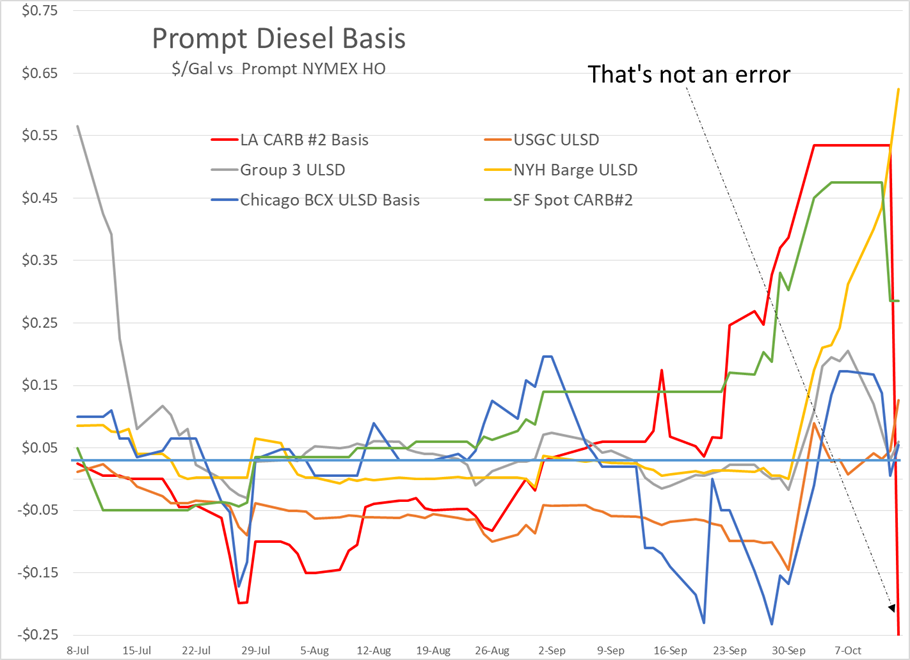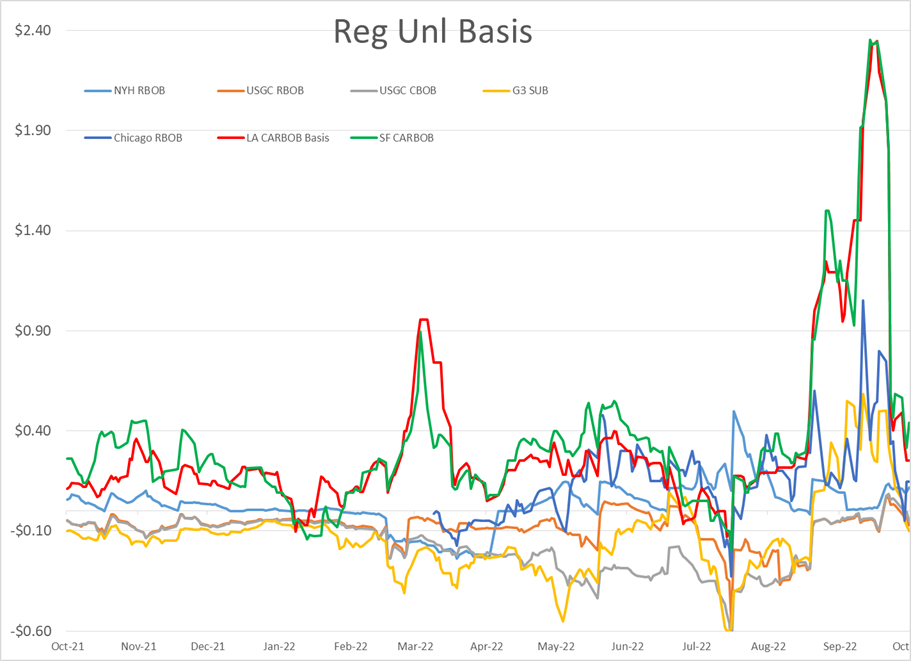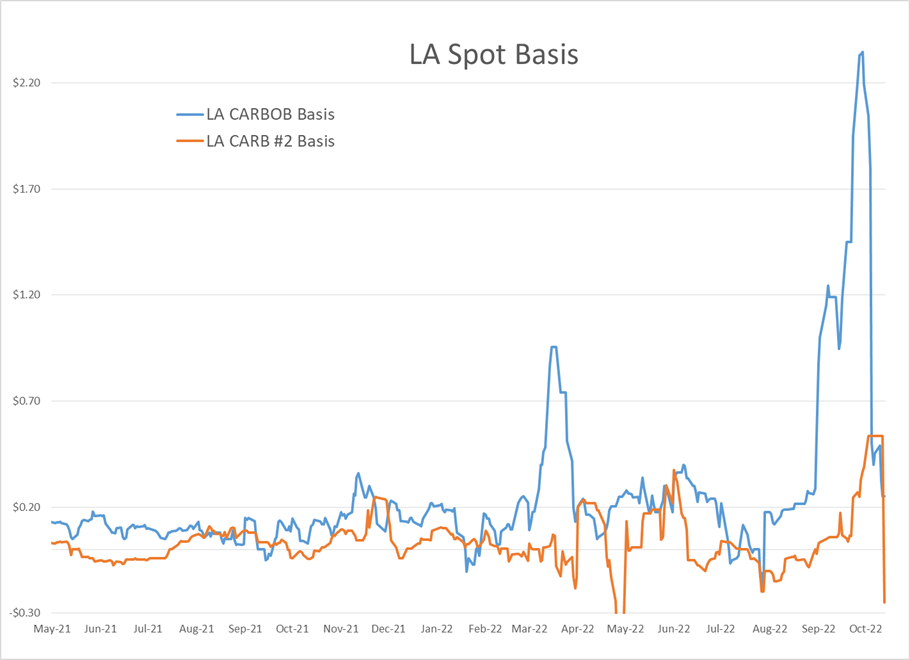US Stock Markets Saw Their Biggest Daily Reversal In Almost 2 Years Thursday

US stock markets saw their biggest daily reversal in almost 2 years Thursday, turning heavy early losses into huge gains. Those swings trickled over into energy markets, adding to the volatility we’ve already become accustomed to in October.
While the swings in futures so far in October have been impressive, the moves in basis values have been epic. After witnessing a $2/gallon collapse in West Coast gasoline values last week, we’ve saw some historic moves in diesel Thursday.
Pretty much everyone that watches West Coast spot markets knew that LA CARB diesel was in for a big drop Thursday, after the other diesel contracts in the region had dropped sharply earlier in the week, but pricing agencies left the CARB diesel unchanged due to a lack of trading activity. While everyone knew a big drop was coming, it’s safe to say that pretty much nobody expected those values to drop more than 78 cents in a day, from +5300 to -2500, which marks a record single day decline for distillates. Ironically, this move happened on the same day that the DOE reported West Coast diesel stocks reached a 3 year low.
We’ve seen bigger drops in gasoline basis in a single day (just last week actually), but I don’t know that any US cash market has ever seen such a swing from a big positive number (which implies very tight supplies) to a big negative (which usually accompanies a glut of product) in just one session. Of course the extreme moves in the ULSD calendar spreads are heavily influencing the daily basis swings, as -2500 vs November futures is the equivalent +1500 vs December futures, and that’s historically a strong basis value for this time of year on the West Coast.
In the other corner of the country, and side of the extreme moves, NY Harbor basis values continued their runaway rally, adding another 25 cents Thursday to now trade 75 cents over November Futures, also known as $1/gallon more than LA CARB diesel , after trading a penny below its West Coast counterpart just 1 day prior. That 75 cent premium is the 2nd highest level recorded for NYH ULSD, and could certainly threaten the record north of $1.22 that was set during the chaotic spring trading after the war in Ukraine broke out. The spread between ULSD values today in New York and at year end is approaching $1.30/gallon.
November ULSD futures came within 5 points of reaching their August high of $4.1154 Thursday, before pulling back slightly ahead of the close, and moving lower overnight. That move is close enough to complete the “W” pattern on the daily charts and may set up a period of sideways trading as traders consolidate positions. That $4.11 level is looking pivotal for the back half of October as a break there leaves room on the charts for a run to $4.50, while a failure will make this look like a short term double top that could push prices sharply lower. Given the chaos in cash markets, expect some more fireworks over the next 2 weeks.
Notes from the DOE’s weekly status report:
US Crude stocks climbed on the week, and nearly reached the 5 year seasonal average for the first time in 18 months. That said, the increase was once again primarily driven by the ongoing release of barrels from the SPR, which are totally more than 7 million barrels every week. US oil production dipped for the 2nd time in 3 weeks and is holding at levels we saw 6 months ago.
Diesel stocks in the US dropped once again, and touched 24.2 days of supply based on the DOE’s demand estimate, which marks the lowest level in the 20+ years of data available. US production of diesel is holding at nearly 1.5 million barrels/day more than the country consumes but record exports are continuing to cause traders to need to pay up to keep barrels at home.
Gasoline demand estimates from the DOE dropped by 1.2 million barrels/day last week, from the top end of the seasonal range, to below the levels we saw this time in 2020. That number is a good reminder of how challenging it is to reliably calculate demand on a short term basis, and that the driving season has officially closed and consumption typically creeps lower for the next 3 months.
News & Views
View All
Energy Futures Are Caught Up In Headline Tug-O-War This Morning
Energy futures are caught up in headline tug-o-war this morning with Canadian oil production concerns and a positive US GDP report trying to push prices higher while sinking Chinese demand worries and Gaza ceasefire hopes are applying downward pressure. The latter two seem to be favored more so far this morning with WTI and Brent crude oil futures down ~45 cents per barrel, while gasoline and diesel prices are down about half a cent and two cents, respectively.
No news is good news? Chicago gasoline prices dropped nearly 30 cents yesterday, despite there not being any update on Exxon’s Joliet refinery after further damage was discovered Wednesday. Its tough to say if traders have realized the supply situation isn’t as bad as originally thought or if this historically volatile market is just being itself (aka ‘Chicago being Chicago’).
The rain isn’t letting up along the Texas Gulf Coast today and is forecasted to carry on through the weekend. While much of the greater Houston area is under flood watch, only two refineries are within the (more serious) flood warning area: Marathon’s Galveston Bay and Valero’s Texas City refineries. However, notification that more work is needed at Phillip’s 66 Borger refinery (up in the panhandle) is the only filing we’ve seen come through the TECQ, so far.
Premiums over the tariff on Colonial’s Line 1 (aka linespace value) returned to zero yesterday, and actually traded in the negatives, after its extended run of positive values atypical of this time of year. Line 1’s counterpart, Line 2, which carries distillates from Houston to Greensboro NC, has traded at a discount so far this year, due to the healthy, if not over-, supply of diesel along the eastern seaboard.
Click here to download a PDF of today's TACenergy Market Talk.

WTI And Brent Crude Oil Futures Are Trading ~$1.50 Per Barrel Lower In Pre-Market Trading
The across-the-board drawdown in national energy stockpiles, as reported by the Department of Energy yesterday, stoked bullish sentiment Wednesday and prompt month gasoline, diesel, and crude oil futures published gains on the day. Those gains are being given back this morning.
The surprise rate cut by the People’s Bank of China is being blamed for the selling we are seeing in energy markets this morning. While the interest rate drop in both short- and medium-term loans won’t likely affect energy prices outright, the concern lies in the overall economic health of the world’s second largest economy and crude oil consumer. Prompt month WTI and Brent crude oil futures are trading ~$1.50 per barrel lower in pre-market trading, gasoline and diesel are following suit, shaving off .0400-.0450 per gallon.
Chicagoland RBOB has maintained its 60-cent premium over New York prices through this morning and shows no sign of coming down any time soon. Quite the opposite in fact: the storm damage, which knocked Exxon Mobil’s Joliet refinery offline on 7/15, seems to be more extensive than initially thought, potentially extending the repair time and pushing back the expected return date.
There are three main refineries that feed the Chicago market, the impact from one of them shutting down abruptly can be seen in the charts derived from aforementioned data published by the DOE. Refinery throughput in PADD 2 dropped 183,000 barrels per day, driving gasoline stockpiles in the area down to a new 5-year seasonal low.
While it seems all is quiet on the Atlantic front (for now), America’s Refineryland is forecasted to receive non-stop rain and thunderstorms for the next four days. While it may not be as dramatic as a hurricane, flooding and power outages can shut down refineries, and cities for that matter, all the same, as we learned from Beryl.

